India national cricket team
| India | |
|---|---|
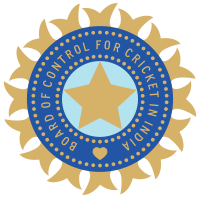 India cricket crest | |
| Test status acquired | 1932 |
| First Test match | v England at Lord's, London, 25–28 June 1932 |
| Captain | Mahendra Singh Dhoni |
| Coach | Duncan Fletcher |
| Official ICC Test, ODI and T20I ranking |
2nd (Test) 1st (ODI) 2nd (T20) |
| Test matches – This year |
474 6 |
| Last Test match | v West Indies at Mumbai, 14–16 November 2013 |
| Wins/losses – This year |
121/149[4] 6/0 |
| As of 30 November 2013 | |
The Indian cricket team is the national cricket team of India. Governed by the Board of Control for Cricket in India (BCCI), it is a full member of the International Cricket Council (ICC) with Test and One Day International (ODI) status.
Although cricket was introduced to India by European merchant sailors in the 18th century, and the first cricket club in India was established in Calcutta in 1792, India's national cricket team did not play its first Test match until 25 June 1932 at Lord's.[5] They became the sixth team to be granted Test cricket status.[6] In its first fifty years of international cricket, India was one of the weakest teams in international cricket, winning only 35 of the 196 Test matches it played during the period.[7] The team, however, gained strength in the 1970s with the emergence of players such as batsmen Sunil Gavaskar and Gundappa Vishwanath, all-rounder Kapil Dev and the Indian spin quartet — Erapalli Prasanna and Srinivas Venkataraghavan (both off spinners), Bhagwat Chandrasekhar (a leg spinner), and Bishen Singh Bedi (a left-arm spinner). Traditionally much stronger at home than abroad, the Indian team has improved its overseas form since the start of the 21st century, winning Test matches in Australia, England and South Africa. It won the Cricket World Cup in 1983 under Kapil Dev, was runner-up in 2003 under Sourav Ganguly, and won the World Cup a second time in 2011 under Mahendra Singh Dhoni. It thus became only the third team after West Indies and Australia to have won the World Cup more than once.[8] It is also the first cricket team to win the World Cup on home soil. India also won the inaugural World Twenty20 in 2007 and 2013 ICC Champions Trophy under the captaincy of Dhoni. India has also been the runner-up in 2000 ICC KnockOut Trophy and the joint champion along with Sri Lanka in 2002 ICC Champions Trophy, led by Ganguly in both the instances.
The Indian cricket team is currently ranked second as per the ICC Test rankings,[9] first in ODIs and second in T20Is by the ICC.[10] Currently, Mahendra Singh Dhoni is the captain in all forms of the game while Duncan Fletcher is the coach. Under the leadership of Dhoni, the Indian team has set a national record for most back-to-back ODI wins (nine straight wins)[11] and has emerged as one of the most formidable teams in international cricket.[12] The Indian cricket team also has rivalries with other Test-playing nations, most notably with Pakistan, the political arch-rival of India. However in recent times, rivalries with nations like Australia, England and South Africa have also gained prominence.
History
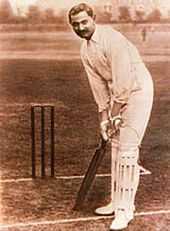
The British brought cricket to India in the early 1700s, with the first cricket match played in 1721.[13] In 1848, the Parsi community in Bombay formed the Oriental Cricket Club, the first cricket club to be established by Indians. After slow beginnings, the Europeans eventually invited the Parsis to play a match in 1877.[14] By 1912, the Parsis, Sikhs, Hindus and Muslims of Bombay played a quadrangular tournament with the Europeans every year.[14] In the early 1900s, some Indians went on to play for the English cricket team. Some of these, such as Ranjitsinhji and KS Duleepsinhji were greatly appreciated by the British and their names went on to be used for the Ranji Trophy and Duleep Trophy - two major first-class tournaments in India. In 1911, an Indian team went on its first official tour of England, but only played English county teams and not the English cricket team.[15] India was invited into The Imperial Cricket Council in 1926, and made its debut as a Test playing nation in 1932, led by CK Nayudu.[16] The match was given Test status despite being only three days in length. The team was not strong in its batting at this point and went on to lose by 158 runs.[17] The Indian team continued to improve throughout the 1930s and '40s but did not achieve an international victory during this period. The team's first series as an independent country was in 1948 against Sir Donald Bradman's Invincibles (a name given to the Australia national cricket team of that time). Australia won the five-match series, 4–0.[18]
India recorded their first Test victory, in their 24th match, against England at Madras (now Chennai) in 1952.[19] Later in the same year, they won their first Test series, which was against Pakistan.[20] They continued their improvement throughout the early 1950s with a series win against New Zealand in 1956. However, they did not win again in the remainder of the decade and lost badly to strong Australian and English sides. The next decade saw India's reputation develop as a team with a strong record at home. They won their first Test series against England at home in 1961–62, and also won a home series against New Zealand. They managed to draw home series against Pakistan and Australia, and another series against England. In this same period, India also won its first series outside the subcontinent, against New Zealand in 1967–68.

The key to India's bowling in the 1970s were the Indian spin quartet – Bishen Bedi, E.A.S. Prasanna, BS Chandrasekhar and Srinivas Venkataraghavan. This period also saw the emergence of two of India's best ever batsmen, Sunil Gavaskar and Gundappa Viswanath. Indian pitches have had tendency to support spin and the spin quartet exploited this to create collapses in opposing batting line-ups. These players were responsible for the back-to-back series wins in 1971 in the West Indies and in England, under the captaincy of Ajit Wadekar. Gavaskar scored 774 runs in the West Indian series while Dilip Sardesai's 112 played a big part in their one Test win.

The advent of One Day International cricket in 1971 created a new dimension in the cricket world. However, India was not considerably strong in ODIs at this point and batsmen such as the captain Gavaskar were known for their defence-based approaches to batting. India began as a weak team in ODIs and did not qualify for the second round in the first two editions of the Cricket World Cup. Gavaskar infamously blocked his way to 36 not out off 174 balls against England in the first World Cup in 1975, India scored just 132 for 3 and lost by 202 runs.
In contrast, India fielded a strong team in Test matches and were particularly strong at home where their combination of stylish batsman and beguiling spinners were seen at their best. India set a then Test record in the third Test against the West Indies at Port-of-Spain in 1976 when they chased 403 to win thanks to 112 from Viswanath. This West Indian defeat is considered to be a watershed in the history of their cricket because it led to captain Clive Lloyd dispensing with spin altogether and relying entirely on a four-man pace attack. In November 1976, the team established another record by scoring 524 for 9 declared against New Zealand at Kanpur without an individual scoring a century. There were six fifties, the highest being 70 by Mohinder Amarnath. The innings was the eighth instance in Test cricket where all eleven batsmen reached double figures.
During the 1980s, India developed a more attack-minded batting line-up with stroke makers such as the wristy Mohammed Azharuddin, Dilip Vengsarkar and all-rounder Ravi Shastri. India won the Cricket World Cup in 1983, defeating the favorites and two-time defending champions West Indies in the final, owing to a strong bowling performance. In spite of this, the team performed poorly in the Test arena, including 28 consecutive Test matches without a victory. In 1984, India won the Asia Cup and in 1985, won the World Championship of Cricket in Australia. Apart from this, India remained a weak team outside the Indian subcontinent. India's Test series victory in 1986 against England remained the last Test series win by India outside the subcontinent for the next 19 years. The 1980s saw Gavaskar and Kapil Dev (India's best all rounder to date) at the pinnacle of their careers. Gavaskar made a Test record 34 centuries as he became the first man to reach the 10,000 run mark. Kapil Dev later became the highest wicket-taker in Test cricket with 434 wickets. The period was also marked by an unstable leadership, with Gavaskar and Kapil exchanging the captaincy several times.
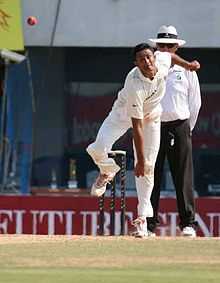
The addition of Sachin Tendulkar and Anil Kumble to the national side in 1989 and 1990 further improved the team. The following year, Javagal Srinath, India's fastest bowler since Amar Singh made his debut. Despite this, during the 1990s, India did not win any of its 33 Tests outside the subcontinent while it won 17 out of its 30 Tests at home. After being eliminated by neighbours Sri Lanka on home soil at the 1996 Cricket World Cup semifinal, the team underwent a year of change as Sourav Ganguly and Rahul Dravid, later to become captains of the team, made their debut in the same Test at Lord's. Tendulkar replaced Azharuddin as captain in late 1996, but after a personal and team form slump, Tendulkar relinquished the captaincy and Azharuddin was reinstated at the beginning of 1998. With the captaincy burden removed, Tendulkar was the world's leading run-scorer in both Tests and ODIs, as India enjoyed a home Test series win over Australia, the best ranked team in the world. After failing to reach the semifinals at the 1999 Cricket World Cup, Tendulkar was again made captain, and had another poor run, losing 3–0 on a tour of Australia and then 2–0 at home to South Africa. Tendulkar resigned, vowing never to captain the team again. Ganguly was appointed the new captain and the team was further damaged in 2000 when former captain Azharuddin and fellow batsman Ajay Jadeja were implicated in a match-fixing scandal and given life and five years bans respectively. This period was described by the BBC as "the Indian cricket's worst hour". However, the new core – Tendulkar, Dravid, Kumble and Ganguly – swore not to let this happen to them again, and lead Indian cricket out of the dark times. And the first three put aside personal ambitions to let Ganguly lead them into a new era.[21]
Since 2000, the Indian team underwent major improvements with the appointment of John Wright as India's first ever foreign coach. India maintained their unbeaten home record against Australia in Test series after defeating them in 2001. The series was famous for the Kolkata Test match, in which India became only the third team in the history of Test cricket to win a Test match after following on. Australian captain Steve Waugh labelled India as the "Final Frontier" as a result of his side's inability to win a Test series in India.[22] Victory in 2001 against the Australians marked the beginning of a dream run for India under their captain Ganguly, winning Test matches in Zimbabwe, Sri Lanka, West Indies and England. The England series is also known for India's highest ODI run-chase of 325 runs at Lord's which came in the Natwest ODI Series final against England. In the same year, India were joint-winners of the ICC Champions Trophy with Sri Lanka, and then went to the 2003 Cricket World Cup in South Africa where they reached the final only to be beaten by Australia. The 2003–04 season also saw India play out a Test series in Australia where they drew 1–1 with the world champions, and then win a Test and ODI series in Pakistan.

At the end of the 2004 season, India suffered from lack of form and fitness from its older players. A defeat in a following home Test series against Australia was followed by an ODI home series defeat against Pakistan followed by a Test series levelled 1–1. Greg Chappell took over from John Wright as the coach of the Indian cricket team following the series, and his methods proved to be controversial during the beginning of his tenure. The tension resulted in a fallout between Chappell and Ganguly, resulting in Rahul Dravid being made captain. This triggered a revival in the team's fortunes, following the emergence of players like Mahendra Singh Dhoni, Suresh Raina, and the coming of age of players like Irfan Pathan and Yuvraj Singh. A thumping home series victory over Sri Lanka in 2005 and a drawn series with South Africa put India at second place in the ICC ODI rankings. Dravid, Tendulkar and Virender Sehwag were selected to play for the ICC World XI in the 2005 "SuperTest" against Australia. A convincing ODI series win in Pakistan in early 2006, following a loss in the Test series, gave India the world record of 17 successive ODI victories while batting second.[23] Towards the middle of 2006, however, a 4–1 series loss in the West Indies gave rise to a slump in India's ODI form, while they achieved a 1–0 victory in the Test series that followed, giving them their first Test series victory in the Caribbean since 1971. India's ODI form slumped further with a disappointing performance in the 2006 Champions Trophy and a drubbing in the ODI series in South Africa. This was followed yet again by an initial good performance in the Tests, giving India its first Test match win in South Africa, although they went on to lose the series 2–1. This Test series was marked by Ganguly's comeback to the Indian team.[24]
In December 2006, India played and won its first ever Twenty20 international in South Africa, becoming the most recent Test team to play Twenty20 cricket. The beginning of 2007 had seen a revival in the Indian team's ODI fortunes before the 2007 Cricket World Cup. Series victories against the West Indies and Sri Lanka, marked by the comeback of Ganguly, and strong form by Tendulkar, and the emergence of young players like Robin Uthappa saw many pundits to tip India as a real contender to win the 2007 Cricket World Cup. However, defeats to Bangladesh and Sri Lanka saw India fail to reach the second round. After winning the Test series against England in August 2007, Dravid stepped down as the captain of the team following which Dhoni was made the captain of the Twenty20 and ODI team. In September 2007, India won the first-ever Twenty20 World Cup held in South Africa, beating Pakistan by 5 runs in the final. In 2007-08, they toured Australia where India lost the controversial Test series 2–1, but managed to win the CB series the following month with a whitewash final of Australia.[25]
In April 2009, India secured their first Test series win in New Zealand in 41 years. After beating Sri Lanka 2–0 in December 2009, India became the No. 1 Test team in the world. They retained the ranking by drawing series against South Africa and Sri Lanka. In October 2010, India whitewashed Australia 2-0 in the home Test series, giving them back-to-back series wins against them. Later that year, India managed to draw the Test series in South Africa at 1-1.[26]
| India's results in international matches | |||||||
|---|---|---|---|---|---|---|---|
| Matches | Won | Lost | Drawn | Tied | No result | Inaugural Match | |
| Test[27] | 472 | 119 | 149 | 203 | 1 | – | 25 June 1932 |
| ODI[28] | 832 | 418 | 373 | - | 6 | 35 | 13 July 1974 |
| T20I[29] | 45 | 24 | 19 | – | 1 | 1 | 1 December 2006 |
On 2 April 2011, India won the 2011 Cricket World Cup by defeating Sri Lanka in the final, thus becoming the second team after West Indies and Australia to win the World Cup twice, the previous win being in 1983. Gautam Gambhir and the skipper Dhoni led the way with 97 and 91* respectively.[30] India also became the first team to the World Cup on home soil.
India were whitewashed 4-0 in away Test series by England in August 2011 due to which England replaced India as the No. 1 Test team in the rankings.[31] This series was followed by another 4-0 whitewash of India in January 2012 in Australia. The disastrous whitewashes saw the retirement of Dravid and VVS Laxman from Test cricket in 2012. Tendulkar retired in November 2013 after his 200th Test match. With Ganguly having retired in 2008, this period signaled the end of the fabled middle-order batting line-up Indian had for a decade.
Governing body
The Board of Control for Cricket in India (BCCI) is the governing body for the Indian cricket team and first-class cricket in India. The Board has been operating since 1929 and represents India at the International Cricket Council. It is amongst the richest sporting organisations in the world. It sold media rights for India's matches from 2006–2010 for US$ 612,000,000.[32] It manages the Indian team's sponsorships, its future tours and team selection.
The International Cricket Council determines India's upcoming matches through its future tours program. However, the BCCI, with its influential financial position in the cricketing world, has often challenged the ICC's program and called for more tours between India, Australia, Pakistan and England which are more likely to earn more revenue as opposed to tours with Bangladesh or Zimbabwe.[33] In the past, the BCCI has also come into conflict with the ICC regarding sponsorships[34] and the legitimacy of the ICC Champions Trophy.
Selection Committee
Selection for the Indian cricket team occurs through the BCCI's zonal selection policy, where each of the five zones is represented with one selector and one of the members nominated by BCCI as the Chairman of the Selection Committee. This has sometimes led to controversy as to whether these selectors are biased towards their zones.[35]
The current chairman of Selection Committee is Sandeep Patil. Roger Binny, Vikram Rathore, Saba Karim and Rajinder Hans are the other members of the selection committee[36] whose terms started in September 2012 with BCCI holding the rights for a one-year extension.
Tournament history
†Cricket was played only at the 1998 Commonwealth Games. Individual records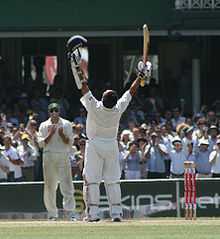 Sachin Tendulkar celebrates his 38th Test century during a match against Australia in 2008. Tendulkar holds multiple world records including the world's leading run-scorer and century maker in both Tests and ODIs.[2] Main article: Indian cricket team records
Sachin Tendulkar, who began playing for India as a 16-year-old in 1989 and has since become the most prolific run-scorer in the history of both Test and ODI cricket, is easily the batsman with the most national achievements. He holds the record of most appearances in both Tests and ODIs, most runs in both Tests and ODIs and most centuries in Tests and ODIs. The highest score by an Indian is the 319 scored by Virender Sehwag in Chennai. It is the second triple century in Test cricket by an Indian, the first being a 309 also made by Sehwag although against Pakistan. The team's highest ever score was a 726/9 against Sri Lanka at Brabourne Stadium, Mumbai in 2009, while its lowest was 42 against England in 1974. In ODIs, the team's highest is 418/5 against West Indies at Indore in 2011-12. India score 413-5 in a match against Bermuda in 2007 World Cup which is the highest score ever in Cricket World Cup history. In the same match, India set a world record of the highest winning margin of 257 runs in an ODI match. India also has had some very strong bowling figures, with spin bowler Anil Kumble being a member of the elite group of 3 bowlers who have taken 600 Test wickets. In 1999, Anil Kumble emulated Jim Laker to become the second bowler to take all ten wickets in a Test match innings when he took 10 wickets for 74 runs against Pakistan at the Feroz Shah Kotla in Delhi. Many of the Indian cricket team's records are also world records, for example Sachin Tendulkar's century tally (in Tests and ODIs) and run tally (also in both Tests and ODIs). Mahendra Singh Dhoni's 183 not out against Sri Lanka in 2005 is the world record score by a wicketkeeper in ODIs. The Indian cricket team also holds the record sequence of 17 successful run-chases in ODIs,[37] which ended in a dramatic match against the West Indies in May 2006, which India lost by just 1 run when Yuvraj Singh was bowled by Dwayne Bravo's full toss. Sachin Tendulkar was the first batsman to score 200 runs (He was unbeaten at 200* which he achieved from 147 deliveries) (25x4 | 3x6), in a single innings, in an ODI on 24 February 2010 against South Africa in Gwalior. On 8 December 2011, this achievement was eclipsed by compatriot Virender Sehwag, who scored 219 runs from 149 deliveries (25x4 | 7x6) versus West Indies in Indore, making the ODI double century club exclusively Indian. Team coloursSince colours have made their way in International Cricket, Indian National Cricket Team has chosen blue as their primary colour and have worn one or the other shade of blue. The blue colour of their uniform has also earned them the nickname of "Men in Blue". With the advent of the World Series Cup in the 1970s, each team was to don a primary and secondary colour on their uniforms. The Indian team elected to wear light-blue as their primary colour and yellow as their secondary colour. Even during the 1999 Cricket World Cup the secondary colour on the Indian cricket team's clothing has been yellow. However, this has since been removed and replaced with the tricolour. However, in the past the Indian ODI outfits were changed to different shades of blue, mostly darker than the current, [citation needed] and the team donned purple during 1992, and then the sky blue colour for the next decade. Indian team has got a new kit from 2009 which is feroza blue with India written on it in Orange.[38] Currently, from October 2010, the team is once again using a light blue shade though not as light as the previous sky blue one, with India written in orange, and shades of the tri-colour at the sides. The kit sponsor for the Indian Cricket Team is Nike, which in 2005 bought the kit rights in a $27.2 million contract with BCCI.[39] Due to their love for blue color Nike with Board for Control of Cricket in India launched the mega campaign called "Bleed Blue" for the support of Indian team in ICC Cricket World Cup 2011 which turned out to be a huge success and people over the internet and places adopted this to cheer for India.[40] A new ultramarine blue coloured jersey of the one-day cricket team was released on 20 October 2010 .,[41] for the upcoming tours and ICC Cricket World Cup, the jersey has been designed by team's apparel and kit sponsor Nike. Previously, the Indian cricket team has worn a darker shade of blue and before that the team has worn sky blue. The vertical tri-colour band has been made on both sides in comparison to just one side in previous shirt. The name of sponsor Sahara had been removed from the chest as per ICC norms and is now on the left arm and on the right arm Nike logo is visible. The name and jersey number of the player is printed in orange at the back while on the chest the logo of BCCI is on the left side and the ICC Cricket World Cup 2011 logo in white can be seen on the right side. The one-day cap was also sky blue with the BCCI logo on the front. When playing first-class cricket, in addition to their cricket whites, Indian fielders sometimes wear a sunhat, which is dark blue and has a wide brim, with the BCCI logo in the middle of the front of the hat. Helmets are coloured similarly. Some players sport the Indian flag on their helmet. The current kit sponsor for the Indian team is Nike, Inc. Test cricket groundsMain article: List of international cricket grounds in India

Wankhede Locations of all stadiums which have hosted a Test match within India
There are numerous world-renowned cricket stadiums located in India. Most grounds are under the administration of various State Cricket Boards as opposed to being under the control of the BCCI. The Bombay Gymkhana was the first ground in India to host a full-scale cricket match featuring an Indian cricket team. This was between the Parsis and the Europeans in 1877. The first stadium to host a Test match in India was also the Gymkhana Ground in Bombay in 1933, the only Test it ever hosted. The second and third Tests in the 1933 series were hosted at Eden Gardens and Chepauk. The Feroz Shah Kotla in Delhi was the first stadium to host a Test match after independence, a draw against the West Indies in 1948, the first of a 5-Test series. 21 stadiums in India have hosted at least one official Test match. In recent years, there has been an increase in the number of world-class cricket stadiums in India, with multiple Test venues in Lucknow, Chandigarh, Chennai, Mumbai, Hyderabad and Nagpur. Eden Gardens in Kolkata has hosted the most Tests, and also has the largest seating capacity of any cricket stadium in the world, being capable of holding more than 90,000 spectators.[42] Founded in 1864, it is one of the most historical stadiums in India, having hosted numerous historical and controversial matches.[43] Other major stadiums in India include the Feroz Shah Kotla, which was established in 1883 and hosted memorable matches including Anil Kumble's ten wickets in an innings haul against Pakistan. For the last two years, the ground has been undergoing renovation.[44] The Bombay Gymkhana hosted the first ever Test match in India which is the only Test it has hosted to date. Wankhede Stadium, established in 1974, has a capacity to hold 33,000 spectators and is currently the most popular venue in the city. It has hosted 21 Test matches. It was the unofficial successor of the Brabourne Stadium, which is also located in Mumbai. Mumbai is often considered the cricketing capital of India because of its fans and the talent it produces (see Mumbai cricket team) and thus the stadium regularly hosts major Test matches.[45] The M. A. Chidambaram Stadium in Chepauk is also considered to be an important historical Indian cricket ground, established in the early 1900s it was the site of India's first Test victory.[46]
PersonnelSquadThis lists all the players who have played for India in the past 12 months, and the forms in which they have played. Correct as of 24 January 2014. Key
The BCCI awards central contracts to its players, its pay graded according to the importance of the player. Players' salaries are as follows:
Coaching staff
StatisticsMain article: India national cricket team record by opponent
| |||||||||||||||||||||||||||||||||||||||||||||||||||||||||||||||||||||||||||||||||||||||||||||||||||||||||||||||||||||||||||||||||||||||||||||||||||||||||||||||||||||||||||||||||||||||||||||||||||||||||||||||||||||||||||||||||||||||||||||||||||||||||||||||||||||||||||||||||||||||||||||||||||||||||||||||||||||||||||||||||||||||||||||||||||||||||||||||||||||||||||||||||||||||||||||||||||||||||||||||||||||||||||||||||||||||||||||||||||||||||||||||||||||||||||||||||||||||||||||||||||||||||||||||||||||||||||||||||||||||||||||||||||||||||||||||||||||||||||||||||||||||||||||||||||||||||||||||||||||||||||||||||||||||||||||||||||||||||||||||||||||||||||||||||||||||||||||||||||||||||||||||||||||||||||||||||||||||||||||||||||||||||||||||||||||||||||||||||||||||||||||||||||||||||||||||||||||||||||||||||||||||||||||||||||||||||||||||||||||||||||||||||||||||||||||||||||||||||||||||||||||||||||||||||||||||||||||||||||||||
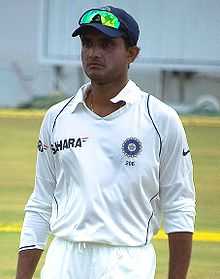


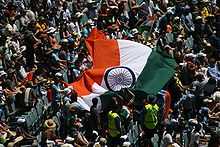

_2.jpg)